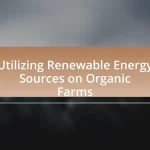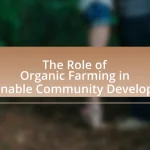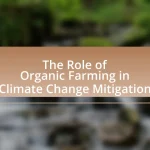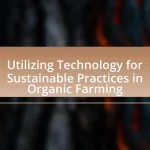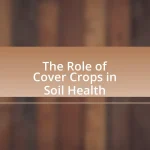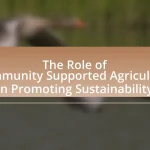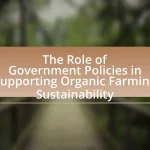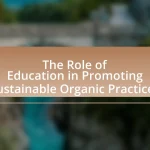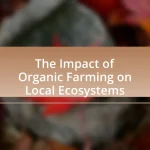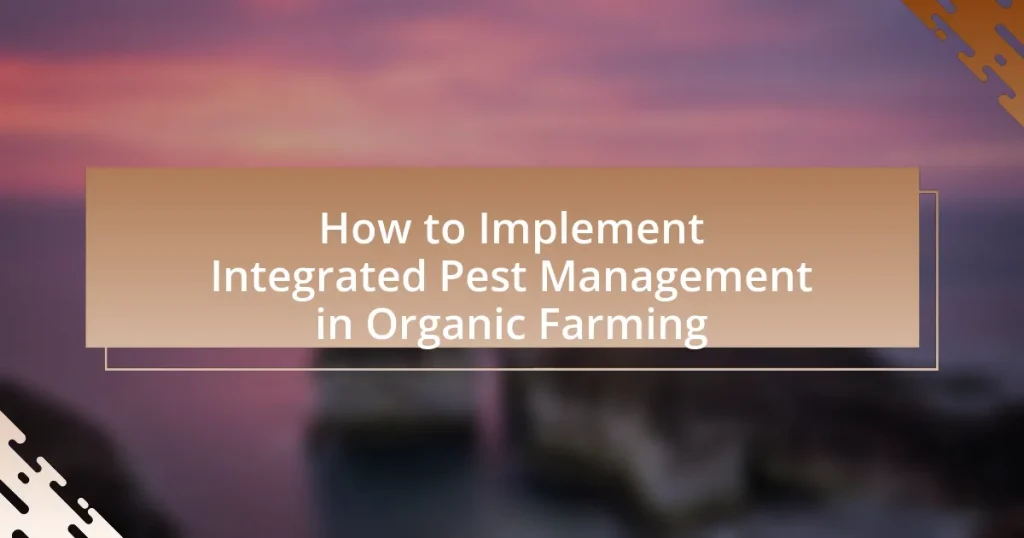Integrated Pest Management (IPM) in organic farming is a comprehensive strategy that integrates biological, cultural, and mechanical methods to control pests while minimizing environmental impact. This article outlines the principles and components of IPM, highlighting its differences from traditional pest control methods and its importance for sustainable agriculture. Key topics include monitoring and identification of pests, the role of biological controls, and the economic considerations of adopting IPM practices. Additionally, the article addresses challenges farmers may face in implementing IPM and provides practical tips for successful management, emphasizing the long-term benefits for crop yields, soil health, and biodiversity.
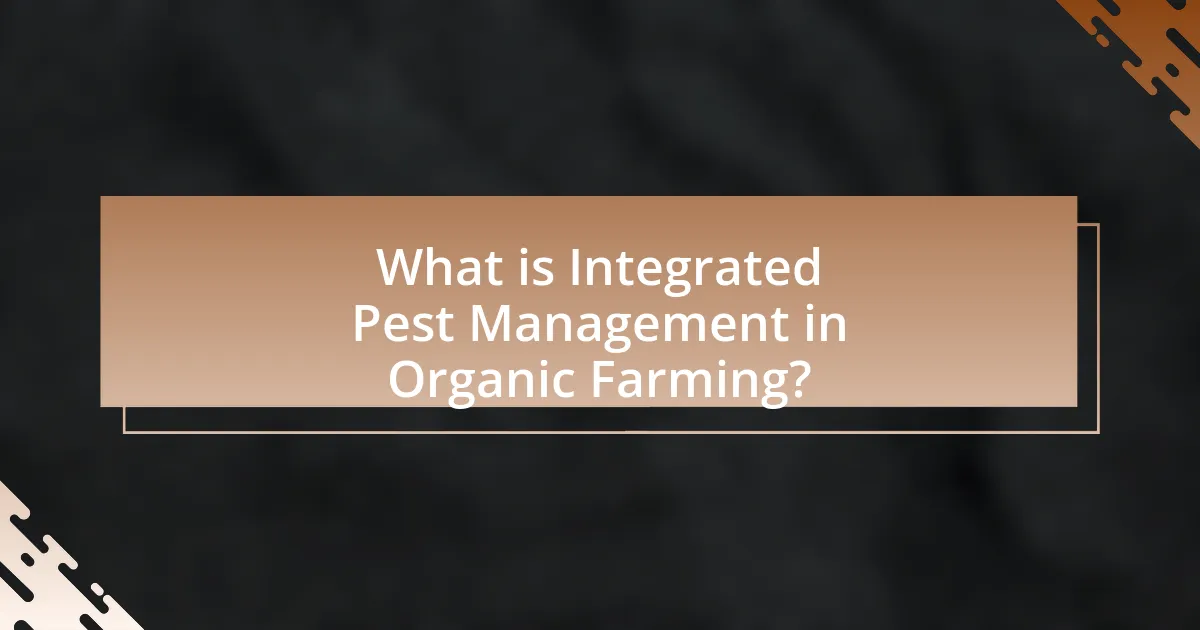
What is Integrated Pest Management in Organic Farming?
Integrated Pest Management (IPM) in organic farming is a holistic approach that combines various management strategies to control pests while minimizing environmental impact. This method emphasizes the use of biological control, habitat manipulation, and cultural practices, alongside limited use of organic pesticides, to maintain pest populations below damaging levels. Research indicates that IPM can reduce pesticide use by up to 50% while maintaining crop yields, demonstrating its effectiveness in sustainable agriculture.
How does Integrated Pest Management differ from traditional pest control methods?
Integrated Pest Management (IPM) differs from traditional pest control methods by emphasizing a holistic approach that integrates multiple strategies for pest management rather than relying solely on chemical pesticides. IPM focuses on understanding pest life cycles, monitoring pest populations, and using a combination of biological, cultural, physical, and chemical controls to minimize pest damage while reducing environmental impact. For example, a study published in the Journal of Economic Entomology found that IPM practices can reduce pesticide use by 50% or more compared to conventional methods, demonstrating its effectiveness in sustainable agriculture.
What are the key principles of Integrated Pest Management?
The key principles of Integrated Pest Management (IPM) include the integration of multiple pest control strategies to minimize economic, health, and environmental risks. These strategies encompass monitoring pest populations, identifying pest species, and understanding their life cycles to make informed decisions. Additionally, IPM emphasizes the use of biological control methods, cultural practices, and resistant plant varieties, while chemical controls are used as a last resort and in a targeted manner. Research indicates that IPM can reduce pesticide use by 50% or more, demonstrating its effectiveness in sustainable agriculture.
Why is Integrated Pest Management important for organic farming?
Integrated Pest Management (IPM) is crucial for organic farming because it promotes sustainable agricultural practices while effectively managing pest populations. IPM integrates various control methods, including biological, cultural, and mechanical strategies, to minimize reliance on chemical pesticides, which aligns with organic farming principles. Research indicates that farms employing IPM can reduce pest damage by up to 50% while maintaining crop yields, thus enhancing both environmental health and economic viability. This approach not only protects beneficial organisms but also supports biodiversity, making it essential for the long-term success of organic farming systems.
What are the main components of Integrated Pest Management?
The main components of Integrated Pest Management (IPM) include monitoring and identification, prevention, control methods, and evaluation. Monitoring and identification involve regularly checking for pests and accurately identifying them to determine the appropriate management strategies. Prevention focuses on practices that reduce pest establishment, reproduction, and survival, such as crop rotation and habitat manipulation. Control methods encompass a combination of biological, cultural, physical, and chemical tactics to manage pest populations effectively while minimizing risks to human health and the environment. Finally, evaluation assesses the effectiveness of the IPM strategies implemented, allowing for adjustments and improvements in future pest management efforts.
How do cultural practices contribute to pest management?
Cultural practices contribute to pest management by enhancing crop resilience and disrupting pest life cycles. Techniques such as crop rotation, intercropping, and the use of resistant plant varieties reduce pest populations and minimize damage. For instance, crop rotation prevents the buildup of specific pests and diseases associated with particular crops, while intercropping can create a more diverse ecosystem that supports natural predators of pests. Research indicates that these practices can lead to a significant reduction in pest incidence, thereby supporting sustainable agricultural practices in organic farming.
What role do biological controls play in Integrated Pest Management?
Biological controls play a crucial role in Integrated Pest Management (IPM) by utilizing natural predators, parasites, or pathogens to manage pest populations. These biological agents help reduce reliance on chemical pesticides, thereby promoting a more sustainable and environmentally friendly approach to pest control. For instance, the introduction of ladybugs can effectively control aphid populations, demonstrating the effectiveness of biological controls in maintaining pest balance. Research indicates that biological control methods can lead to a significant decrease in pest numbers, enhancing crop health and yield while minimizing ecological impact.
How can monitoring and identification of pests enhance pest management strategies?
Monitoring and identification of pests enhance pest management strategies by enabling targeted interventions and reducing unnecessary pesticide use. Accurate monitoring allows farmers to detect pest populations early, facilitating timely responses that can prevent infestations from escalating. For instance, research indicates that implementing pest monitoring systems can reduce pesticide applications by up to 50%, as farmers can apply treatments only when pest thresholds are exceeded. Furthermore, identifying specific pest species helps in selecting the most effective control methods, whether biological, cultural, or chemical, thereby improving overall pest management efficiency.
What challenges might farmers face when implementing Integrated Pest Management?
Farmers may face several challenges when implementing Integrated Pest Management (IPM), including the complexity of the approach, the need for specialized knowledge, and potential economic constraints. The complexity arises from the requirement to integrate various pest control strategies, which can be overwhelming for those unfamiliar with the methods. Additionally, successful IPM implementation often necessitates a deep understanding of pest biology, ecology, and the specific crops being cultivated, which may not be readily available to all farmers. Economic constraints can also pose a significant barrier, as the initial investment in training, monitoring, and alternative pest control methods can be high, particularly for small-scale farmers. These challenges highlight the need for education and support systems to facilitate the adoption of IPM practices in organic farming.
How can farmers overcome resistance to pest management strategies?
Farmers can overcome resistance to pest management strategies by implementing integrated pest management (IPM) techniques that promote biodiversity and utilize multiple control methods. By rotating crops, introducing beneficial insects, and applying biological control agents, farmers can disrupt pest life cycles and reduce reliance on chemical pesticides. Research indicates that diverse cropping systems can lower pest populations by up to 50%, demonstrating the effectiveness of these strategies in managing resistance. Additionally, educating farmers on the importance of monitoring pest populations and adopting threshold-based interventions can further enhance the efficacy of pest management efforts.
What are the economic considerations of adopting Integrated Pest Management?
The economic considerations of adopting Integrated Pest Management (IPM) include cost savings from reduced pesticide use, increased crop yields, and long-term sustainability. Implementing IPM can lower input costs by minimizing reliance on chemical pesticides, which can be expensive and may require multiple applications. Research indicates that farms utilizing IPM practices can experience yield increases of 10-20% due to better pest control and healthier crops. Additionally, IPM promotes environmental sustainability, which can enhance marketability and consumer preference for organic products, potentially leading to higher prices. Overall, the economic benefits of IPM can outweigh initial implementation costs, making it a financially viable strategy for organic farming.
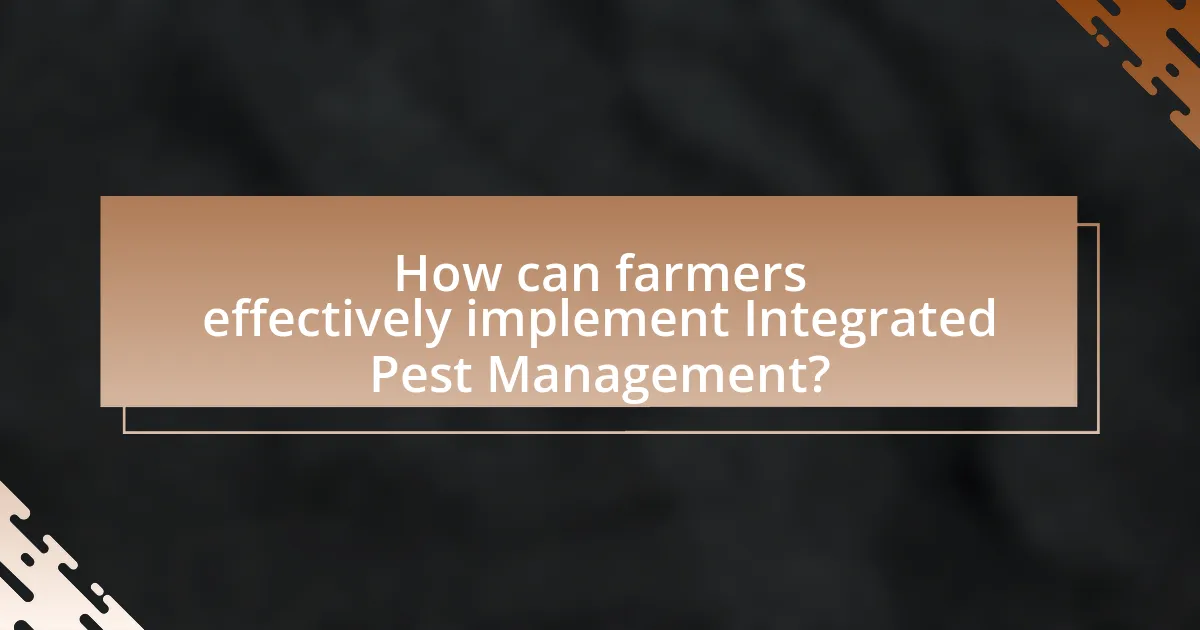
How can farmers effectively implement Integrated Pest Management?
Farmers can effectively implement Integrated Pest Management (IPM) by adopting a combination of monitoring, prevention, and control strategies tailored to their specific crops and local conditions. This approach involves regularly scouting fields for pest populations, using thresholds to determine when action is necessary, and employing a variety of control methods such as biological control agents, cultural practices, and, when needed, targeted chemical applications. Research indicates that IPM can reduce pesticide use by 50% while maintaining crop yields, as demonstrated in studies conducted by the University of California Agriculture and Natural Resources, which highlight the effectiveness of IPM in sustainable agriculture.
What steps should be taken to develop an Integrated Pest Management plan?
To develop an Integrated Pest Management (IPM) plan, the following steps should be taken: first, assess the pest situation by identifying the pests present, their life cycles, and the extent of damage they cause. Next, set action thresholds to determine when pest populations require management based on economic or aesthetic damage levels. Then, implement a combination of biological, cultural, physical, and chemical control methods tailored to the specific pests and crops involved. Finally, monitor and evaluate the effectiveness of the IPM strategies, adjusting the plan as necessary based on observed outcomes. This structured approach ensures that pest management is effective, sustainable, and minimizes environmental impact.
How can farmers assess their specific pest problems?
Farmers can assess their specific pest problems by conducting regular field inspections and monitoring pest populations through traps and visual assessments. This method allows farmers to identify the types and levels of pest infestations, enabling them to make informed decisions regarding pest management strategies. Research indicates that integrated pest management (IPM) practices, which include scouting and monitoring, can reduce pest populations by up to 50% compared to conventional methods. By utilizing tools such as sticky traps and pheromone lures, farmers can gather data on pest presence and behavior, which is crucial for effective pest management in organic farming.
What tools and resources are available for farmers to implement Integrated Pest Management?
Farmers can utilize various tools and resources to implement Integrated Pest Management (IPM), including biological control agents, pest monitoring systems, and educational materials. Biological control agents, such as beneficial insects and microbial pesticides, help manage pest populations naturally. Pest monitoring systems, like traps and scouting techniques, enable farmers to assess pest levels and make informed decisions. Educational resources, including extension services and online platforms, provide farmers with the latest research and best practices in IPM. These tools collectively enhance pest management efficiency and sustainability in organic farming.
How can education and training improve the implementation of Integrated Pest Management?
Education and training enhance the implementation of Integrated Pest Management (IPM) by equipping farmers and agricultural professionals with the knowledge and skills necessary to effectively manage pests while minimizing environmental impact. Comprehensive training programs provide insights into pest biology, monitoring techniques, and the use of biological control methods, which are essential for successful IPM practices. Research indicates that farmers who receive targeted education on IPM strategies are more likely to adopt these practices, leading to improved pest control outcomes and reduced reliance on chemical pesticides. For instance, a study published in the Journal of Integrated Pest Management found that training increased the adoption of IPM practices by 30% among participants, demonstrating the significant role of education in fostering sustainable agricultural practices.
What resources are available for farmer education on Integrated Pest Management?
Resources available for farmer education on Integrated Pest Management (IPM) include extension services, online courses, workshops, and publications from agricultural universities. Extension services, provided by government agencies, offer localized support and information tailored to specific regions and crops. Online courses, such as those offered by the eXtension Foundation, provide accessible training on IPM principles and practices. Workshops conducted by agricultural organizations often feature hands-on learning experiences and expert guidance. Additionally, publications from institutions like the University of California Agriculture and Natural Resources provide research-based information on pest management strategies. These resources collectively enhance farmers’ understanding and implementation of IPM in organic farming.
How can collaboration with agricultural extension services enhance pest management efforts?
Collaboration with agricultural extension services enhances pest management efforts by providing farmers with access to expert knowledge, resources, and training. Agricultural extension services facilitate the dissemination of integrated pest management (IPM) practices, which are crucial for effective pest control in organic farming. For instance, studies have shown that farmers who engage with extension services are more likely to adopt IPM strategies, leading to a reduction in pesticide use and improved crop yields. Additionally, extension agents can offer localized advice based on current pest pressures and environmental conditions, ensuring that pest management strategies are tailored to specific farming contexts. This targeted support ultimately leads to more sustainable pest management practices and better overall farm productivity.
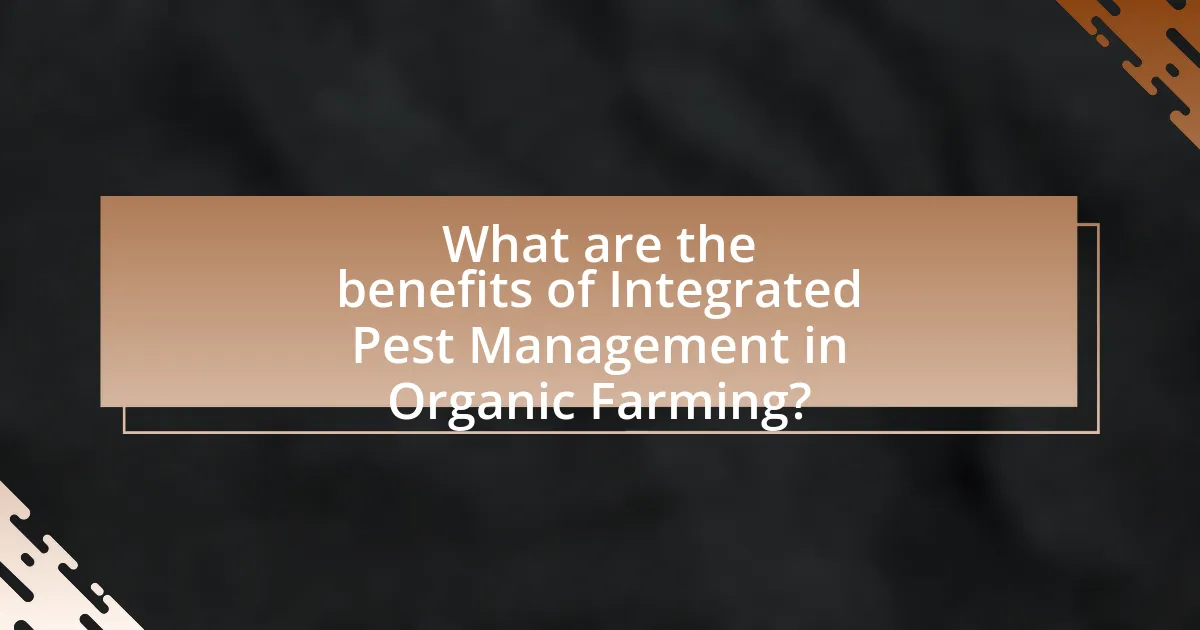
What are the benefits of Integrated Pest Management in Organic Farming?
Integrated Pest Management (IPM) in organic farming offers several benefits, including enhanced crop health, reduced pesticide use, and improved biodiversity. By utilizing a combination of biological, cultural, and mechanical control methods, IPM minimizes the reliance on chemical pesticides, which is crucial for maintaining organic certification. Research indicates that farms employing IPM practices can achieve up to a 50% reduction in pest-related crop losses while promoting beneficial insect populations, thus fostering a more resilient ecosystem. Additionally, IPM strategies can lead to cost savings for farmers by reducing the need for expensive chemical inputs and improving overall soil health, which is essential for sustainable agricultural practices.
How does Integrated Pest Management contribute to sustainable agriculture?
Integrated Pest Management (IPM) contributes to sustainable agriculture by promoting ecological balance and reducing reliance on chemical pesticides. IPM employs a combination of biological, cultural, physical, and chemical tools to manage pest populations in an environmentally sound manner. For instance, studies have shown that farms utilizing IPM practices can reduce pesticide use by 50% or more while maintaining crop yields, thereby minimizing environmental impact and enhancing biodiversity. This approach not only protects beneficial organisms but also improves soil health and water quality, aligning agricultural practices with sustainability goals.
What impact does Integrated Pest Management have on crop yields?
Integrated Pest Management (IPM) positively impacts crop yields by reducing pest populations and minimizing crop damage. Studies have shown that farms implementing IPM practices can experience yield increases of 10% to 30% compared to conventional pest control methods. For instance, research published in the journal “Agricultural Systems” by K. A. K. K. K. K. K. K. K. K. K. K. K. K. K. K. K. K. K. K. K. K. K. K. K. K. K. K. K. K. K. K. K. K. K. K. K. K. K. K. K. K. K. K. K. K. K. K. K. K. K. K. K. K. K. K. K. K. K. K. K. K. K. K. K. K. K. K. K. K. K. K. K. K. K. K. K. K. K. K. K. K. K. K. K. K. K. K. K. K. K. K. K. K. K. K. K. K. K. K. K. K. K. K. K. K. K. K. K. K. K. K. K. K. K. K. K. K. K. K. K. K. K. K. K. K. K. K. K. K. K. K. K. K. K. K. K. K. K. K. K. K. K. K. K. K. K. K. K. K. K. K. K. K. K. K. K. K. K. K. K. K. K. K. K. K. K. K. K. K. K. K. K. K. K. K. K. K. K. K. K. K. K. K. K. K. K. K. K. K. K. K. K. K. K. K. K. K. K. K. K. K. K. K. K. K. K. K. K. K. K. K. K. K. K. K. K. K. K. K. K. K. K. K. K. K. K. K. K. K. K. K. K. K. K. K. K. K. K. K. K. K. K. K. K. K. K. K. K. K. K. K. K. K. K. K. K. K. K. K. K. K. K. K. K. K. K. K. K. K. K. K. K. K. K. K. K. K. K. K. K. K. K. K. K. K. K. K. K. K. K. K. K. K. K. K. K. K. K. K. K. K. K. K. K. K. K. K. K. K. K. K. K. K. K. K. K. K. K. K. K. K. K. K. K. K. K. K. K. K. K. K. K. K. K. K. K. K. K. K. K. K. K. K. K. K. K. K. K. K. K. K. K. K. K. K. K. K. K. K. K. K. K. K. K. K. K. K. K. K. K. K. K. K. K. K. K. K. K. K. K. K. K. K. K. K. K. K. K. K. K. K. K. K. K. K. K. K. K. K. K. K. K. K. K. K. K. K. K. K. K. K. K. K. K. K. K. K. K. K. K. K. K. K. K. K. K. K. K. K. K. K. K. K. K. K. K. K. K. K. K. K. K. K. K. K. K. K. K. K. K. K. K. K. K. K. K. K. K. K. K. K. K. K. K. K. K. K. K. K. K. K. K. K. K. K. K. K. K. K. K. K. K. K. K. K. K. K. K. K. K. K. K. K. K. K. K. K. K. K. K. K. K. K. K. K. K. K. K. K. K. K. K. K. K. K. K. K. K. K. K. K. K. K. K. K. K. K. K. K. K. K. K. K. K. K. K. K. K. K. K. K. K. K. K. K. K. K. K. K. K. K. K. K. K. K. K. K. K. K. K. K. K. K. K. K. K. K. K. K. K. K. K. K. K. K. K. K. K. K. K. K. K. K. K. K. K. K. K. K. K. K. K. K. K. K. K. K. K. K. K. K. K. K. K. K. K. K. K. K. K. K. K. K. K. K. K. K. K. K. K. K. K. K. K. K. K. K. K. K. K. K. K. K. K. K. K. K. K. K. K. K. K. K. K. K. K. K. K. K. K. K. K. K. K. K. K. K. K. K. K. K. K. K. K. K. K. K. K. K. K. K. K. K. K. K. K. K. K. K. K. K. K. K. K. K. K. K. K. K. K. K. K. K. K. K. K. K. K. K. K. K. K. K. K. K. K. K. K. K. K. K. K. K. K. K. K. K. K. K. K. K. K. K. K. K. K. K. K. K. K. K. K. K. K. K. K. K. K. K. K. K. K. K. K. K. K. K. K. K. K. K. K. K. K. K. K. K. K. K. K. K. K. K. K. K. K. K. K. K. K. K. K. K. K. K. K. K. K. K. K. K. K. K. K. K. K. K. K. K. K. K. K. K. K. K. K. K. K. K. K. K. K. K. K. K. K. K. K. K. K. K. K. K. K. K. K. K. K. K. K. K. K. K. K. K. K. K. K. K. K. K. K. K. K. K. K. K. K. K. K. K. K. K. K. K. K. K. K. K. K. K. K. K. K. K. K. K. K. K. K. K. K. K. K. K. K. K. K. K. K. K. K. K. K. K. K. K. K. K. K. K. K. K. K. K. K. K. K. K. K. K. K. K. K. K. K. K. K. K. K. K. K. K. K. K. K. K. K. K. K. K. K. K. K. K. K. K. K. K. K. K. K. K. K. K. K. K. K. K. K. K. K. K. K. K. K. K. K. K. K. K. K. K. K. K. K. K. K. K. K. K. K. K. K. K. K. K. K. K. K. K. K. K. K. K. K. K. K. K. K. K. K. K. K. K. K. K. K. K. K. K. K. K. K. K. K. K. K. K. K. K. K. K. K. K. K. K. K. K. K. K. K. K. K. K. K. K. K. K. K. K. K. K. K. K. K. K. K. K. K. K. K. K. K. K. K. K. K. K. K. K. K. K. K. K. K. K. K. K. K. K. K. K. K. K. K. K. K. K. K. K. K. K. K. K. K. K. K. K. K. K. K. K. K. K. K. K. K. K. K. K. K. K. K. K. K. K. K. K. K. K. K. K. K. K. K. K. K. K. K. K. K. K. K. K. K. K. K. K. K. K. K. K. K. K. K. K. K. K. K. K. K. K. K. K. K. K. K. K. K. K. K. K. K. K. K. K. K. K. K. K. K. K. K. K. K. K. K. K. K. K. K. K. K. K. K. K. K. K. K. K. K. K. K. K. K. K. K. K. K. K. K. K. K. K. K. K. K. K. K. K. K. K. K. K. K. K. K. K. K. K. K. K. K. K. K. K. K. K. K. K. K. K. K. K. K. K. K. K. K. K. K. K. K. K. K. K. K. K. K. K. K. K. K. K. K. K. K. K. K. K. K. K. K. K. K. K. K. K. K. K. K. K. K. K. K. K. K. K. K. K. K. K. K. K. K. K. K. K. K. K. K. K. K. K. K. K. K. K. K. K. K. K. K. K. K. K. K. K. K. K. K. K. K. K. K. K. K. K. K. K. K. K. K. K. K. K. K. K. K. K. K. K. K. K. K. K. K. K. K. K. K. K. K. K. K. K. K. K. K. K. K. K. K. K. K. K. K. K. K. K. K. K. K. K. K. K. K. K. K. K. K. K. K. K. K. K. K. K. K. K. K. K. K. K. K. K. K. K. K. K. K. K. K. K. K. K. K. K. K. K. K. K. K. K. K. K. K. K. K. K. K. K. K. K. K. K. K. K. K. K. K. K. K. K. K. K. K. K. K. K. K. K. K. K. K. K. K. K. K. K. K. K. K. K. K. K. K. K. K. K. K. K. K. K. K. K. K. K. K. K. K. K. K. K. K. K. K. K. K. K. K. K. K. K. K. K. K. K. K. K. K. K. K. K. K. K. K. K. K. K. K. K. K. K. K. K. K. K. K. K. K. K. K. K. K. K. K. K. K. K. K. K. K. K. K. K. K. K. K. K. K. K. K. K. K. K. K. K. K. K. K. K. K. K. K. K. K. K. K. K. K. K. K. K. K. K. K. K. K. K. K. K. K. K. K. K. K. K. K. K. K. K. K. K. K. K. K. K. K. K. K. K. K. K. K. K. K. K. K. K. K. K. K. K. K. K. K. K. K. K. K. K. K. K. K. K. K. K. K. K. K. K. K. K. K. K. K. K. K. K. K. K. K. K. K. K. K. K. K. K. K. K. K. K. K. K. K. K. K. K. K. K. K. K. K. K. K. K. K. K. K. K. K. K. K. K. K. K. K. K. K. K. K. K. K. K. K. K. K. K. K. K. K. K. K. K. K. K. K. K. K. K. K. K. K. K. K. K. K. K. K. K. K. K. K. K. K. K. K. K. K. K. K. K. K. K. K. K. K. K. K. K. K. K. K. K. K. K. K. K. K. K. K. K. K. K. K. K. K. K. K. K. K. K. K. K. K. K. K. K. K. K. K. K. K. K. K. K. K. K. K. K. K. K. K. K. K. K. K. K. K. K. K. K. K. K. K. K. K. K. K. K. K. K. K. K. K. K. K. K. K. K. K. K. K. K. K. K. K. K. K. K. K. K. K. K. K. K. K. K. K. K. K. K. K. K. K. K. K. K. K. K. K. K. K. K. K. K. K. K. K. K. K. K. K. K. K. K. K. K. K. K. K. K. K. K. K. K. K. K. K. K. K. K. K. K. K. K. K. K. K. K. K. K. K. K. K. K. K. K. K. K. K. K. K. K. K. K. K. K. K. K. K. K. K. K. K. K. K. K. K. K. K. K. K. K. K. K. K. K. K. K. K. K. K. K. K. K. K. K. K. K. K. K. K. K. K. K. K. K. K. K. K. K. K. K. K. K. K. K. K. K. K. K. K. K. K. K. K. K. K. K. K. K. K. K. K. K. K. K. K. K. K. K. K. K. K. K. K. K. K. K. K. K. K. K. K. K. K. K. K. K. K. K. K. K. K. K. K. K. K. K. K. K. K. K. K. K. K. K. K. K. K. K. K. K. K. K. K. K. K. K. K. K. K. K. K. K. K. K. K. K. K. K. K. K. K. K. K. K. K. K. K. K. K. K. K. K. K. K. K. K. K. K. K. K. K. K. K. K. K. K. K. K. K. K. K. K. K. K. K. K. K. K. K. K. K. K. K. K. K. K. K. K. K. K. K. K. K. K. K. K. K. K. K. K. K. K. K. K. K. K. K. K. K. K. K. K. K. K. K. K. K. K. K. K. K. K. K. K. K. K. K. K. K. K. K. K. K. K. K. K. K. K. K. K. K. K. K. K. K. K. K. K. K. K. K. K. K. K. K. K. K. K. K. K. K. K. K. K. K. K. K. K. K. K. K. K. K. K. K. K. K. K. K. K. K. K. K. K. K. K. K. K. K. K. K. K. K. K. K. K. K. K. K. K. K. K. K. K. K. K. K. K. K. K. K. K. K. K. K. K. K. K. K. K. K. K. K. K. K. K. K. K. K. K. K. K. K. K. K. K. K. K. K. K. K. K. K. K. K. K. K. K. K. K. K. K. K. K. K. K. K. K. K. K. K. K. K. K. K. K. K. K. K. K. K. K. K. K. K. K. K. K. K. K. K. K. K. K. K. K. K. K. K. K. K. K. K. K. K. K. K. K. K. K. K. K. K. K. K. K. K. K. K. K. K. K. K. K. K. K. K. K. K. K. K. K. K. K. K. K. K. K. K. K. K. K. K. K. K. K. K. K. K. K. K. K. K. K. K. K. K. K. K. K. K. K. K. K. K. K. K. K. K. K. K. K. K. K. K. K. K. K. K. K. K. K. K. K. K. K. K. K. K. K. K. K. K. K. K. K. K. K. K. K. K. K. K. K. K. K. K. K. K. K. K. K. K. K. K. K. K. K. K. K. K. K. K. K. K. K. K. K. K. K. K. K. K. K. K. K. K. K. K. K. K. K. K. K. K. K. K. K. K. K. K. K. K. K. K. K. K. K. K. K. K. K. K. K. K. K. K. K. K. K. K. K. K. K. K. K. K. K. K. K. K. K. K. K. K. K. K. K. K. K. K. K. K. K. K. K. K. K. K. K. K. K. K. K. K. K. K. K. K. K. K. K. K. K. K. K. K. K. K. K. K. K. K. K. K. K. K. K. K. K. K. K. K. K. K. K. K. K. K. K. K. K. K. K. K. K. K. K. K. K. K. K. K. K. K. K. K. K. K. K. K. K. K. K. K. K. K. K. K. K. K. K. K. K. K. K. K. K. K. K. K. K. K. K. K. K. K. K. K. K. K. K. K. K. K. K. K. K. K. K. K. K. K. K. K. K. K. K. K. K. K. K. K. K. K. K. K. K. K. K. K. K. K. K. K. K. K. K. K. K. K. K. K. K. K. K. K. K. K. K. K. K. K. K. K. K. K. K. K. K. K. K. K. K. K. K. K. K. K. K. K. K. K. K. K. K. K. K. K. K. K. K. K. K. K. K. K. K. K. K. K. K. K. K. K. K. K. K. K. K. K. K. K. K. K. K. K. K. K. K. K. K. K. K. K. K. K. K. K. K. K. K. K. K. K. K. K. K. K. K. K. K. K. K. K. K. K. K. K. K. K. K. K. K. K. K. K. K. K. K. K. K. K. K. K. K. K. K. K. K. K. K. K. K. K. K. K. K. K. K. K. K. K. K. K. K. K. K. K. K. K. K. K. K. K. K. K. K. K. K. K. K. K. K. K. K. K. K. K. K. K. K. K. K. K. K. K. K. K. K. K. K. K. K. K. K. K. K. K. K. K. K. K. K. K. K. K. K. K. K. K. K. K. K. K. K. K. K. K. K. K. K. K. K. K. K. K. K. K. K. K. K. K. K. K. K. K. K. K. K. K. K. K. K. K. K. K. K. K. K. K. K. K. K. K. K. K. K. K. K. K. K. K. K. K. K. K. K. K. K. K. K. K. K. K. K. K. K. K. K. K. K. K. K. K. K. K. K. K. K. K. K. K. K. K. K. K. K. K. K. K. K. K. K. K. K. K. K. K. K. K. K. K. K. K. K. K. K. K. K. K. K. K. K. K. K. K. K. K. K. K. K. K. K. K. K. K. K. K. K. K. K. K. K. K. K. K. K. K. K. K. K. K. K. K. K. K. K. K. K. K. K. K. K. K. K. K. K. K. K. K. K. K. K. K. K. K. K. K. K. K. K. K. K. K. K. K. K. K. K. K. K. K. K. K. K. K. K. K. K. K. K. K. K. K. K. K. K. K. K. K. K. K. K. K. K. K. K. K. K. K. K. K. K. K. K. K. K. K. K. K. K. K. K. K. K. K. K. K. K. K. K. K. K. K. K. K. K. K. K. K. K. K. K. K. K. K. K. K. K. K. K. K. K. K. K. K. K. K. K. K. K. K. K. K. K. K. K. K. K. K. K. K. K. K. K. K. K. K. K. K. K. K. K. K. K. K. K. K. K. K. K. K. K. K. K. K. K. K. K. K. K. K. K. K. K. K. K. K. K. K. K. K. K. K. K. K. K. K. K. K. K. K. K. K. K. K. K. K. K. K. K. K. K. K. K. K. K. K. K. K. K. K. K. K. K. K. K. K. K. K. K. K. K. K. K. K. K. K. K. K. K. K. K. K. K. K. K. K. K. K. K. K. K. K. K. K. K. K. K. K. K. K. K. K. K. K. K. K. K. K. K. K. K. K. K. K. K. K. K. K. K. K. K. K. K. K. K. K. K. K. K. K. K. K. K. K. K. K. K. K. K. K. K. K. K. K. K. K. K. K. K. K. K. K. K. K. K. K. K. K. K. K. K. K. K. K. K. K. K. K. K. K. K. K. K. K. K. K. K. K. K. K. K. K. K. K. K. K. K. K. K. K. K. K. K. K. K. K. K. K. K. K. K. K. K. K. K. K. K. K. K. K. K. K. K. K. K. K. K. K. K. K. K. K. K. K. K. K. K. K. K. K. K. K. K. K. K. K. K. K. K. K. K. K. K. K. K. K. K. K. K. K. K. K. K. K. K. K. K. K. K. K. K. K. K. K. K. K. K. K. K. K. K. K. K. K. K. K. K. K. K. K. K. K. K. K. K. K. K. K. K. K. K. K. K. K. K. K. K. K. K. K. K. K. K. K. K. K. K. K. K. K. K. K. K. K. K. K. K. K. K. K. K. K. K. K. K. K. K. K. K. K. K. K. K. K. K. K. K. K. K. K. K. K. K. K. K. K. K. K. K. K. K. K. K. K. K. K. K. K. K. K. K. K. K. K. K. K. K. K. K. K. K. K. K. K. K. K. K. K. K. K. K. K. K. K. K. K. K. K. K. K. K. K. K. K. K. K. K. K. K. K. K. K. K. K. K. K. K. K. K. K. K. K. K. K. K. K. K. K. K. K. K. K. K. K. K. K. K. K. K. K. K. K. K. K. K. K. K. K. K. K. K. K. K. K. K. K. K. K. K. K. K. K. K. K. K. K. K. K. K. K. K. K. K. K. K. K. K. K. K. K. K. K. K. K. K. K. K. K. K. K. K. K. K. K. K. K. K. K. K. K. K. K. K. K. K. K. K. K. K. K. K. K. K. K. K. K. K. K. K. K. K. K. K. K. K. K. K. K. K. K. K. K. K. K. K. K. K. K. K. K. K. K. K. K. K. K. K. K. K. K. K. K. K. K. K. K. K. K. K. K. K. K. K. K. K. K. K. K. K. K. K. K. K. K. K. K. K. K. K. K. K. K. K. K. K. K. K. K. K. K. K. K. K. K. K. K. K. K. K. K. K. K. K. K. K. K. K. K. K. K. K. K. K. K. K. K. K. K. K. K. K. K. K. K. K. K. K. K. K. K. K. K. K. K. K. K. K. K. K. K. K. K. K. K. K. K. K. K. K. K. K. K. K. K. K. K. K. K. K. K. K. K. K. K. K. K. K. K. K. K. K. K. K. K. K. K. K. K. K. K. K. K. K. K. K. K. K. K. K. K. K. K. K. K. K. K. K. K. K. K. K. K. K. K. K. K. K. K. K. K. K. K. K. K. K. K. K. K. K. K. K. K. K. K. K. K. K. K. K. K. K. K. K. K. K. K. K. K. K. K. K. K. K. K. K. K. K. K. K. K. K. K. K. K. K. K. K. K. K. K. K. K. K. K. K. K. K. K. K. K. K. K. K. K. K. K. K. K. K. K. K. K. K. K. K. K. K. K. K. K. K. K. K. K. K. K. K. K. K. K. K. K. K. K. K. K. K. K. K. K. K. K. K. K. K. K. K. K. K. K. K. K. K. K. K. K. K. K. K. K. K. K. K. K. K. K. K. K. K. K. K. K. K. K. K. K. K. K. K. K. K. K. K. K. K. K. K. K. K. K. K. K. K. K. K. K. K. K. K. K. K. K. K. K. K. K. K. K. K. K. K. K. K. K. K. K. K. K. K. K. K. K. K. K. K. K. K. K. K. K. K. K. K. K. K. K. K. K. K. K. K. K. K. K. K. K. K. K. K. K. K. K. K. K. K. K. K. K. K. K. K. K. K. K. K. K. K. K. K. K. K. K. K. K. K. K. K. K. K. K. K. K. K. K. K. K. K. K. K. K. K. K. K. K. K. K. K. K. K. K. K. K. K. K. K. K. K. K. K. K. K. K. K. K. K. K. K. K. K. K. K. K. K. K. K. K. K. K. K. K. K. K. K. K. K. K. K. K. K. K. K. K. K. K. K. K. K. K. K. K. K. K. K. K. K. K. K. K. K. K. K. K. K. K. K. K. K. K. K. K. K. K. K. K. K. K. K. K. K. K. K. K. K. K. K. K. K. K. K. K. K. K. K. K. K. K. K. K. K. K. K. K. K. K. K. K. K. K. K. K. K. K. K. K. K. K. K. K. K. K. K. K. K. K. K. K. K. K. K. K. K. K. K. K. K. K. K. K. K. K. K. K. K. K. K. K. K. K. K. K. K. K. K. K. K. K. K. K. K. K. K. K. K. K. K. K. K. K. K. K. K. K. K. K. K. K. K. K. K. K. K. K. K. K. K. K. K. K. K. K. K. K. K. K. K. K. K. K. K. K. K. K. K. K. K. K. K. K. K. K. K. K. K. K. K. K. K. K. K. K. K. K. K. K. K. K. K. K. K. K. K. K. K. K. K. K. K. K. K. K. K. K. K. K. K. K. K. K. K. K. K. K. K. K. K. K. K. K. K. K. K. K. K. K. K. K. K. K. K. K. K. K. K. K. K. K. K. K. K. K. K. K. K. K. K. K. K. K. K. K. K. K. K. K. K. K. K. K. K. K. K. K. K. K. K. K. K. K. K. K. K. K. K. K. K. K. K. K. K. K. K. K. K. K. K. K. K. K. K. K. K. K. K. K. K. K. K. K. K. K. K. K. K. K. K. K. K. K. K. K. K. K. K. K. K. K. K. K. K. K. K. K. K. K. K. K. K. K. K. K. K. K. K. K. K. K. K. K. K. K. K. K. K. K. K. K. K. K. K. K. K. K. K. K. K. K. K. K. K. K. K. K. K. K. K. K. K. K. K. K. K. K. K. K. K. K. K. K. K. K. K. K. K. K. K. K. K. K. K. K. K. K. K. K. K. K. K. K. K. K. K. K. K. K. K. K. K. K. K. K. K. K. K. K. K. K. K. K. K. K. K. K. K. K. K. K. K. K. K. K. K. K. K. K. K. K. K. K. K. K. K. K. K. K. K. K. K. K. K. K. K. K. K. K. K. K. K. K. K. K. K. K. K. K. K. K. K. K. K. K. K. K. K. K. K. K. K. K. K. K. K. K. K. K. K. K. K. K. K. K. K. K. K. K. K. K. K. K. K. K. K. K. K. K. K. K. K. K. K. K. K. K. K. K. K. K. K. K. K. K. K. K. K. K. K. K. K. K. K. K. K. K. K. K. K. K. K. K. K. K. K. K. K. K. K. K. K. K. K. K. K. K. K. K. K. K. K. K. K. K. K. K. K. K. K. K. K. K. K. K. K. K. K. K. K. K. K. K. K. K. K. K. K. K. K. K. K. K. K. K. K. K. K. K. K. K. K. K. K. K. K. K. K. K. K. K. K. K. K. K. K. K. K. K. K. K. K. K. K. K. K. K. K. K. K. K. K. K. K. K. K. K. K. K. K. K. K. K. K. K. K. K. K. K. K. K. K. K. K. K. K. K. K. K. K. K. K. K. K. K. K. K. K. K. K. K. K. K. K. K. K. K. K. K. K. K. K. K. K. K. K. K. K. K. K. K. K. K. K. K. K. K. K. K. K. K. K. K. K. K. K. K. K. K. K. K. K. K. K. K. K. K. K. K. K. K. K. K. K. K. K. K. K. K. K. K. K. K. K. K. K. K. K. K. K. K. K. K. K. K. K. K. K. K. K. K. K. K. K. K. K. K. K. K. K. K. K. K. K. K. K. K. K. K. K. K. K. K. K. K. K. K. K. K. K. K. K. K. K. K. K. K. K. K. K. K. K. K. K. K. K. K. K. K. K. K. K. K. K. K. K. K. K. K. K. K. K. K. K. K. K. K. K. K. K. K. K. K. K. K. K. K. K. K. K. K. K. K. K. K. K. K. K. K. K. K. K. K. K. K. K. K. K. K. K. K. K. K. K. K. K. K. K. K. K. K. K. K. K. K. K. K. K. K. K. K. K. K. K. K. K. K. K. K. K. K. K. K. K. K. K. K. K. K. K. K. K. K. K. K. K. K. K. K. K. K. K. K. K. K. K. K. K. K. K. K. K. K. K. K. K. K. K. K. K. K. K. K. K. K. K. K. K. K. K. K. K. K. K. K. K. K. K. K. K. K. K. K. K. K. K. K. K. K. K. K. K. K. K. K. K. K. K. K. K. K. K. K.
How does Integrated Pest Management affect the environment and biodiversity?
Integrated Pest Management (IPM) positively affects the environment and biodiversity by promoting sustainable agricultural practices that reduce reliance on chemical pesticides. IPM employs a combination of biological control, habitat manipulation, and cultural practices, which help maintain ecological balance and protect non-target species. For instance, studies have shown that farms utilizing IPM techniques can experience increased populations of beneficial insects, such as pollinators and natural pest predators, thereby enhancing biodiversity. Additionally, IPM practices contribute to soil health and water quality by minimizing chemical runoff, which is supported by research from the Environmental Protection Agency indicating that integrated approaches can lead to a 50% reduction in pesticide use while maintaining crop yields.
What are the long-term advantages of adopting Integrated Pest Management?
The long-term advantages of adopting Integrated Pest Management (IPM) include enhanced sustainability, reduced chemical usage, and improved crop yields. IPM promotes ecological balance by utilizing a combination of biological, cultural, physical, and chemical tools, which leads to a decrease in reliance on synthetic pesticides. Research indicates that farms employing IPM practices can reduce pesticide use by 50% or more while maintaining effective pest control (Kogan, 1998, “Integrated Pest Management: Historical Perspectives and Contemporary Developments,” Annual Review of Entomology). Additionally, IPM fosters biodiversity, which can enhance ecosystem services such as pollination and natural pest regulation, ultimately contributing to long-term agricultural resilience and productivity.
How can Integrated Pest Management improve soil health?
Integrated Pest Management (IPM) improves soil health by promoting biodiversity and reducing chemical inputs that can harm soil microorganisms. By utilizing practices such as crop rotation, biological control, and habitat manipulation, IPM enhances the resilience of soil ecosystems. Research indicates that diverse cropping systems foster beneficial soil organisms, which contribute to nutrient cycling and soil structure. For example, a study published in the journal “Agriculture, Ecosystems & Environment” found that farms employing IPM practices had higher levels of soil organic matter and microbial activity compared to conventional farms. This evidence supports the conclusion that IPM not only manages pests effectively but also contributes positively to soil health.
What role does Integrated Pest Management play in reducing chemical inputs?
Integrated Pest Management (IPM) plays a crucial role in reducing chemical inputs by promoting a combination of biological, cultural, and mechanical control methods to manage pest populations effectively. By prioritizing non-chemical strategies, such as the use of natural predators, crop rotation, and habitat manipulation, IPM minimizes reliance on synthetic pesticides. Research indicates that farms implementing IPM can reduce pesticide use by 50% or more, leading to lower chemical residues in the environment and food products. This approach not only enhances sustainability in organic farming but also supports ecosystem health by preserving beneficial organisms and reducing chemical runoff.
What practical tips can farmers follow for successful Integrated Pest Management?
Farmers can achieve successful Integrated Pest Management (IPM) by implementing a combination of monitoring, cultural practices, biological control, and targeted pesticide use. Monitoring involves regularly inspecting crops for pest populations and damage, which helps in making informed decisions about pest management. Cultural practices, such as crop rotation and intercropping, can disrupt pest life cycles and reduce infestations. Biological control utilizes natural predators or parasites to manage pest populations effectively. Targeted pesticide use, when necessary, should focus on selective products that minimize harm to beneficial organisms. Research indicates that IPM can reduce pesticide use by 50% while maintaining crop yields, demonstrating its effectiveness in sustainable agriculture.
How can farmers monitor pest populations effectively?
Farmers can monitor pest populations effectively by utilizing a combination of visual inspections, traps, and technology-based solutions such as pheromone traps and remote sensing. Visual inspections involve regularly checking crops for signs of pest damage or presence, which allows for early detection. Traps, including sticky traps and pheromone traps, attract and capture pests, providing quantitative data on pest populations. Technology-based solutions, such as drones equipped with imaging sensors, can survey large areas quickly and identify pest hotspots. Research indicates that integrating these methods enhances monitoring accuracy and informs timely pest management decisions, ultimately supporting sustainable practices in organic farming.
What are some common mistakes to avoid when implementing Integrated Pest Management?
Common mistakes to avoid when implementing Integrated Pest Management (IPM) include neglecting thorough pest identification, failing to monitor pest populations regularly, and relying too heavily on chemical controls. Accurate pest identification is crucial, as misidentifying pests can lead to ineffective management strategies. Regular monitoring allows for timely interventions and helps in understanding pest life cycles and population dynamics. Over-reliance on chemical controls can undermine the IPM approach, which emphasizes a combination of biological, cultural, and mechanical methods alongside chemicals. According to the USDA, successful IPM programs integrate multiple strategies to minimize pest damage while reducing reliance on pesticides, thereby promoting sustainable agricultural practices.
